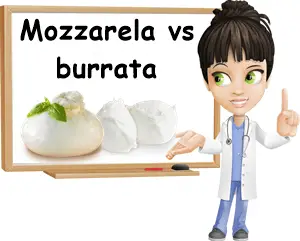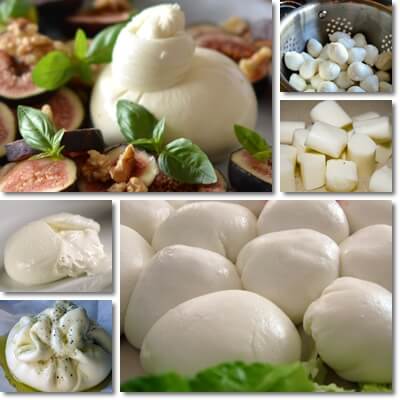Mozzarella is a fresh, Italian buffalo milk cheese while burrata is essentially a mozzarella pouch filled with cream. Some would say they are basically the same cheese since they’re both, well, made from mozzarella. Others would say that burrata is a type of mozzarella, although this isn’t a very accurate statement. Yet the addition of a single ingredient and the changes that come with it as far as taste, texture, culinary uses and nutritional profile are concerned make them two quite distinct cheese varieties. And believe me, eating burrata is not the same thing as eating fresh mozzarella.
So what is the difference, or better said, what are the differences between mozzarella and burrata? In order to better understand the differences between these two cheeses, let’s first see what is mozzarella and what is burrata more exactly.
1) What is mozzarella? Mozzarella is a fresh Italian cheese made originally from Italian water buffalo milk. Nowadays it’s common for mozzarella to be made from cow milk as well as Italian water buffalo milk. Mozzarella is a particular type of cheese that undergoes a special process called ‘pasta filata’.

Essentially, the cheese curds are submerged in hot water or hot whey to soften them and get an elastic cheese that can be stretched into various shapes or kneaded. ‘Pasta filata’ means ‘spun paste’ and refers to the fact that the mozzarella is, at one point in its product process, a stretchy paste. The final product, the mozzarella, maintains a certain elasticity which is why it’s also called a stretched curd or plastic curd type of cheese. See full article on the Properties and Benefits of Mozzarella.
2) What is burrata? Burrata is a fresh Italian cheese made from fresh mozzarella and filled with fresh mozzarella shreds and cream. The mozzarella is prepared using the traditional ‘pasta filata’ method and stretched and kneaded into a pouch. The pouch is quickly filled with fresh, shredded mozzarella (which is called ‘stracciatella’) and lots of cream, then closed by stretching and kneading. The filling is added as soon as the mozzarella is shaped, while it’s still warm and malleable so it can better hold the filling. Originally, burrata cheese was tied with fresh leaves of asphodel to indicate freshness – asphodel leaves typically wilted in 2 to 4 days, so any wilted, dried leaves meant the burrata was past its best before date.
Burrata was also originally made from Italian water buffalo milk, but is now being made from cow milk as well. Because the pouch holding the filling is made from mozzarella, burrata is also sometimes called ‘burrata mozzarella’ or considered a by-product or sub-type of mozzarella cheese. However, despite the common ingredients, they are two different types of cheese. See full article on the Properties and Benefits of Burrata.
Similarities
In many ways, the two cheese varieties are similar. Actually, here are the most striking similarities between burrata and mozzarella:
1) Both are made from fresh mozzarella cheese.
2) Both are made from Italian water buffalo and cow’s milk.
3) They are both fresh cheese varieties (not aged) that are best consumed within a limited time span.
4) For the most part, they are round-shaped: mozzarella is usually shaped like a ball, while burrata a rounded pouch.
5) Both come in various sizes, ranging from less than 100 g to 0.5 kg and 1 kg balls of cheese.
6) They are milky white in color, rarely yellowish (the water buffaloes and cows’ diets dictate milk and cheese color).
7) Mozzarella and burrata are semi-soft cheeses.
8) They have a high-moisture content and often moistened with whey upon serving (or in the case of mozzarella, packaged in whey).
9) From a nutritional point of view, burrata and mozzarella are relatively high in fat, protein and boast a moderately high energetic value. Both cheeses are rich in calcium, phosphorus, vitamin B12 and moderate sources of vitamin A, sodium and zinc.

What is the difference between mozzarella and burrata?
Burrata is not mozzarella and here is why:
1) Burrata is a cheese with filling, while mozzarella is without filling (solid, one-piece cheese).
2) Both are semi-soft cheeses, but mozzarella is visibly firmer while burrata is softer because of its soft, shredded mozzarella and cream filling (with occasional soft chunks forming in the filling).
3) Mozzarella has a slightly elastic, stringy texture, while burrata is a mix of textures: slightly stretchy mozzarella pouch and soft, creamy, thick flowing cream filling.
4) Fresh mozzarella, which is the real mozzarella, has a fresh, milky taste with no other distinct flavor notes; some people find mozzarella taste quite bland. Because of its thick, cream filling, burrata has a rich milky, fatty, even buttery flavor – quite distinct from fresh mozzarella.
5) While there is a reduced-moisture mozzarella with a longer shelf life (especially made for pizza), smoked mozzarella and mozzarella in brine (salt water or salted whey solutions), burrata comes only in fresh form.
6) The original mozzarella is made from Italian water buffalo milk and, nowadays, also cow’s milk. For those with intolerance or sensitivities to cow’s milk, there is also sheep and goat milk mozzarella available in some parts of Italy or specialty artisanal cheese shops. However, burrata is usually made only from Italian water buffalo and cow’s milk.
7) Mozzarella is eaten fresh or cooked (used on pizza and in lasagna); burrata is made for eating fresh (there aren’t really any recipes that call for cooking burrata).
8) Burrata has only one shape: rounded pouch of cheese with filling (and comes in various sizes). Mozzarella shapes include: mozzarella balls (ranging from the size of a grape to up to 1 kg in weight); cylinders of mozzarella (especially for reduced-moisture mozzarella used for pizza-making), mozzarella sticks, rolls and ‘mozzarella nodini’ (or mozzarella knots).
Nutritional differences between mozzarella and burrata
9) Burrata is likely to have more vitamin A and vitamin E than mozzarella. Vitamins A and E are fat soluble vitamins and are found for the most part in the fatty part of milk, in the cream. Because burrata has a rich cream filling (and mozzarella doesn’t) and cream contains most of the vitamin A and E in milk, chances are it is higher in these vitamins.
10) Mozzarella nutritional value is more constant because of the more controlled production process (this applies to regular, whole milk mozzarella). Burrata nutritional profile may vary depending on how much cream filling is added to the mozzarella pouch, whether or not the mozzarella pouch is made thinner or thicker or if shredded mozzarella is added to the filling or just cream.
11) While original mozzarella is made from whole milk, there are also non-fat mozzarella and skim-milk mozzarella varieties available. Burrata can be made with just cream filling or shredded mozzarella and cream filling (original recipe). There is no non-fat burrata because the cheese requires a cream filling and cream is naturally a rich source of fat. There isn’t also much interest in making low-fat burrata either since anyone looking to try burrata – a cheese with a fatty, cream filling – knows they are looking to eat something fatty.
12) Burrata is more likely to cause acid reflux and trigger gastritis symptoms compared to mozzarella because of its fattier cream filling. However, anyone with acid reflux disease or gastritis should avoid eating mozzarella and burrata too frequently or in large amounts and especially avoid eating the two cheese varieties at night. See my list of Foods to Eat and to Avoid for Acid Reflux and Foods to Eat and to Avoid for Gastritis.
13) Non-fat mozzarella has up to 50% less calories and almost no fat compared to regular, whole milk mozzarella and burrata. Non-fat mozzarella also has more protein, more calcium, but less fat-soluble vitamins A, E, D and K compared to regular, whole milk mozzarella and burrata.
14) Burrata has less sodium than mozzarella. 100 g of burrata cheese may contain anywhere from 214 to 317 mg of sodium, while mozzarella has about 486 mg of sodium.
